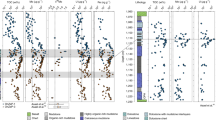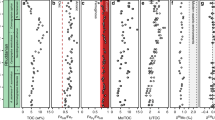Abstract
Despite its important biological and biogeochemical consequences1,2,3, the identification of extensive oceanic anoxia in the geological record is controversial. In particular, global anoxia is difficult to distinguish from spatially restricted anoxia in the deep ocean, or in tectonically isolated basins such as the modern Black Sea. The marine isotope geochemistry of molybdenum (Mo) can help quantify the past oxygenation state of the ocean4,5,6,7,8,9,10,11,12,13,14, because to first approximation under oxic conditions lighter isotopes of Mo are preferentially removed to sediments, whereas in euxinic conditions quantitative removal leads to no fractionation. However, the isotopic composition of the Mo input from rivers, the main contributor of Mo to the oceans, is poorly constrained and had been assumed to be isotopically comparable to the narrow range found in a small dataset of continental rocks4,5,6,7,8,9,10,11,12,13,14. Here we present an isotopic analysis of Mo in a set of rivers that together account for 22% of the global riverine water discharge. We find a broad range of variability in the Mo isotopic composition of these rivers, with almost all samples enriched in the heavy isotopes compared with continental rocks. Our data remove key uncertainties associated with the marine Mo isotope budget14 and strongly suggest near-total anoxia in the mid-Proterozoic ocean8 as well as during Mesozoic ocean anoxic events13.
This is a preview of subscription content, access via your institution
Access options
Subscribe to this journal
Receive 12 print issues and online access
$259.00 per year
only $21.58 per issue
Buy this article
- Purchase on Springer Link
- Instant access to full article PDF
Prices may be subject to local taxes which are calculated during checkout



Similar content being viewed by others
References
Anbar, A. D. & Knoll, A. H. Proterozoic ocean chemistry and evolution: A bioinorganic bridge? Science 297, 1137–1142 (2002).
Grice, K. et al. Photic zone euxinia during the Permian–Triassic superanoxic event. Science 307, 706–709 (2005).
Jenkyns, H. C. Evidence for rapid climate change in the Mesozoic–Palaeogene greenhouse world. Phil. Trans. R. Soc. London A 361, 1885–1916 (2003).
Barling, J., Arnold, G. L. & Anbar, A. D. Natural mass-dependent variations in the isotopic composition of molybdenum. Earth Planet. Sci. Lett. 193, 447–457 (2001).
McManus, J., Nägler, T. F., Siebert, C., Wheat, C. F. & Hammond, D. E. Oceanic molybdenum isotope fractionation: Diagensis and hydrothermal ridge-flank alteration. Geochem. Geophys. Geosyst. 3, doi:10.1029/2002GC000356 (2002).
Siebert, C., Nägler, T. F., von Blanckenburg, F. & Kramers, J. D. Molybdenum isotope records as a potential new proxy for paleoceanography. Earth Planet. Sci. Lett. 211, 159–171 (2003).
Barling, J. & Anbar, A. D. Molybdenum isotope fractionation during adsorption by manganese oxides. Earth Planet. Sci. Lett. 217, 315–329 (2004).
Arnold, G. L., Anbar, A. D., Barling, J. & Lyons, T. W. Molybdenum isotope evidence for widespread anoxia in Mid-Proterozoic oceans. Science 304, 87–89 (2004).
Nägler, T. F., Siebert, C., Lüschen, H. & Böttcher, M. E. Sedimentary Mo isotope record across the Holocene fresh–brackish water transition of the Black Sea. Chem. Geol. 219, 283–295 (2005).
Siebert, C., McManus, J., Bice, A., Poulson, R. & Berelson, W. M. Molybdenum isotope signatures in continental margin marine sediments. Earth Planet. Sci. Lett. 241, 723–733 (2006).
Poulson, R., Siebert, C., McManus, J. & Berelson, W. M. Authigenic molybdenum isotope signatures in marine sediments. Geology 34, 617–620 (2006).
McManus, J. et al. Molybdenum and uranium geochemistry in continental margin sediments: Paleoproxy potential. Geochim. Cosmochim. Acta 70, 4643–4662 (2006).
Pearce, C. R., Cohen, A. S., Coe, A. L. & Burton, K. W. Molybdenum isotope evidence for global ocean anoxia coupled with perturbations to the carbon cycle during the early Jurassic. Geology 36, 231–234 (2008).
Ling, H.-F., Gao, J.-F., Zhao, K.-D., Jiang, S.-Y. & Ma, D.-S. Comment on ‘Molybdenum isotope evidence for widespread anoxia in the Mid-Proterozoic oceans’. Science 309, 1017c (2005).
Morford, J. L. & Emerson, S. The geochemistry of redox sensitive trace metals in sediments. Geochim. Cosmochim. Acta 63, 1735–1750 (1999).
Anbar, A. D. & Rouxel, O. Metal stable isotopes in paleoceanography. Annu. Rev. Earth Planet. Sci. 31, 717–746 (2007).
Erickson, B. E. & Helz, G. R. Molybdenum (VI) speciation in sulfidic waters: Stability and lability of thiomolybdenites. Geochim. Cosmochim. Acta 64, 1149–1158 (2000).
Kaback, D. S. & Runnells, D. D. Geochemistry of molybdenum in some stream sediments and waters. Geochim. Cosmochim. Acta 44, 447–456 (1980).
Bertine, K. K. The Marine Geochemical Cycle of Chromium and Molybdenum. Thesis, Yale, 67 (1970).
Malinovsky, D., Hammarlund, D., Ilyashuk, B., Martinsson, O. & Gelting, J. Variations in the isotopic composition of molybdenum in freshwater lake systems. Chem. Geol. 236, 181–198 (2007).
Pontér, C., Ingri, J. & Boström, K. Geochemistry of manganese in the Kalix River, northern Sweden. Geochim. Cosmochim. Acta 56, 1485–1494 (1992).
Rondeau, B., Cossa, D., Gagnon, P., Pham, T. T. & Surette, C. Hydrological and biogeochemical dynamics of the minor and trace elements in the St. Lawrence River. Appl. Geochem. 20, 1391–1408 (2005).
Huh, Y., Chan, L. H., Zhang, L. & Edmond, J. M. Lithium and its isotopes in major world rivers: Implications for weathering and the oceanic budget. Geochim. Cosmochim. Acta 62, 2039–-2051 (1998).
Goldberg, S. & Forster, H. S. Factors affecting molybdenum adsorption by soils and minerals. Soil Sci. 163, 109–114 (1998).
Kisakurek, B., James, R. H. & Harris, N. B. W. Li and δ7Li in Himalayan rivers: Proxies for silicate weathering? Earth Planet. Sci. Lett. 237, 387–401 (2005).
Holland, H. D. in Treatise in Geochemistry (eds Holland, H. D. & Turekian, K. K.) 583–625 (Elsevier, Oxford, 2004).
Canfield, D. E. A new model for Proterozoic ocean chemistry. Nature 396, 450–453 (1998).
Bermin, J., Vance, D., Archer, C. & Statham, P. J. The determination of the isotopic composition of Cu and Zn in seawater. Chem. Geol. 226, 280–297 (2006).
Archer, C. & Vance, D. Mass discrimination correction in plasma source mass spectrometry: An example using Cu and Zn isotopes. J. Anal. Atom. Spectr. 19, 656–665 (2004).
Siebert, C., Nägler, T. F. & Kramer, J. D. Determination of molybdenum isotope fractionation by double-spike multicollector inductively coupled mass spectrometry. Geochem. Geophys. Geosyst. 2, 2000GC000124 (2001).
Acknowledgements
This research was supported by the NERC. We also thank J. Perkins, R. Mills, D. Teagle, A. Scrivner, A. El Sheikh, H. Kerr, J. Simpson, A. Page and N. Harris for their help with collection of the various river samples. We thank T. Elliott, C. Hawkesworth, J. McManus, A. Anbar for comments on an earlier draft. Jim’s review, particularly, fundamentally changed and improved the manuscript.
Author information
Authors and Affiliations
Corresponding author
Supplementary information
Supplementary Information
Supplementary tables S1-S2 (PDF 116 kb)
Rights and permissions
About this article
Cite this article
Archer, C., Vance, D. The isotopic signature of the global riverine molybdenum flux and anoxia in the ancient oceans. Nature Geosci 1, 597–600 (2008). https://doi.org/10.1038/ngeo282
Received:
Accepted:
Published:
Issue Date:
DOI: https://doi.org/10.1038/ngeo282
This article is cited by
-
Molybdenum cycling in Andean-type subduction and metallogenic implications
Mineralium Deposita (2023)
-
Ultra-trace Element Characterization of the Central Ottawa River Basin using a Rapid, Flexible, and Low-volume ICP-MS Method
Aquatic Geochemistry (2020)
-
Fully oxygenated water columns over continental shelves before the Great Oxidation Event
Nature Geoscience (2019)
-
A molybdenum-isotope perspective on Phanerozoic deoxygenation events
Nature Geoscience (2017)
-
Variation of molybdenum isotopes in molybdenite from porphyry and vein Mo deposits in the Gangdese metallogenic belt, Tibetan plateau and its implications
Mineralium Deposita (2016)



